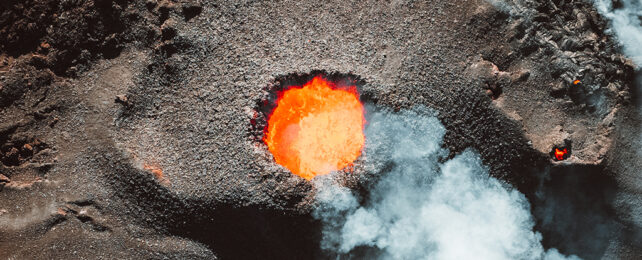Antibiotics discovered in the soil of a Cameroon volcano half a century ago have finally been reverse-engineered by Japanese researchers, giving medical scientists a new potential drug in the fight against infection.
In 1974, German chemist Axel Zeeck and his Turkish colleague Mithat Mardin showed red pigments produced by the bacterium Streptomyces arenae have antimicrobial properties, making them an attractive material for pharmacologists to tinker with.
Synthesizing the potentially useful compounds known as β- and γ-naphthocyclinone in useful quantities proved to be a challenge. Some trial and error is often required to figure out the necessary chemical reactions, though complexity of the naphthocyclinones make them difficult to create without introducing a wide variety of byproducts along the way.
Only now have researchers from the Institute of Science Tokyo been able to get the job done, using an approach known as retrosynthetic analysis.
As you might guess from the name, it involves working backwards from a target molecule to figure out its basic building blocks. It's a bit like breaking down a complex machine into its component parts – parts that are easier to understand and assemble.

The team started with β-naphthocyclinone, as γ-naphthocyclinone can be considered a variation. Like many large molecules, a combination of simpler molecular units served as a starting point for the compound's construction.
Bridging the two units is a complex molecule called bicyclo[3.2.1]octadienone, though getting the chemical into the perfect position without changing the other components or creating an entirely different product is easier said than done.
Guided by their retrosynthetic recipe and applying a number of advanced chemistry methods, the researchers found a path that allowed them to position the pieces with precision and bond them in a way that didn't affect their function.
The moment of truth came in comparing the exact 3D atom arrangements – or in scientific terms, the circular dichroism spectra – of the synthesized compounds with those created by nature in the volcano.
"The circular dichroism spectra of our synthesized compounds were identical to those of naturally occurring ones, implying that the absolute configuration of synthetic and natural molecules was the same," says chemist Yoshio Ando from the Institute of Science Tokyo.
These methods finally enabled the researchers to synthesize β-naphthocyclinone with a yield of at least 70 percent (so 70 percent of the maximum amount expected given the starting materials).
They then used another chemical process, oxidative lactonization, to produce γ-naphthocyclinone with a yield of 87 percent. The two compounds are similar, but γ-naphthocyclinone has some added extras.
Synthesizing the antibiotics in a lab could see them produced in larger quantities for medical and research use: there's no need to take regular trips back to a volcano, for example. What's more, the researchers think the carefully calibrated approaches they used here can be used in future studies as well – particularly in synthesizing other compounds with similar structures.
"Further efforts along these lines are already in progress in our laboratory," says Ando.
The research has been published in Angewandte Chemie International Edition.
